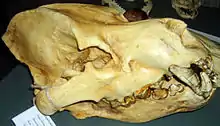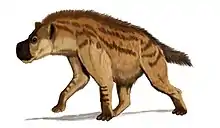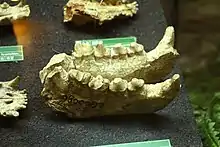Dinocrocuta
Dinocrocuta is an extinct genus of hyena-like feliform carnivores. It lived in Asia, and Africa, during the Miocene epoch. It had very strong jaws that were able to crush bones.[1][2]
| Dinocrocuta | |
|---|---|
 | |
| D. gigantea skull cast, Zoologisk Museum | |
| Scientific classification | |
| Kingdom: | Animalia |
| Phylum: | Chordata |
| Class: | Mammalia |
| Order: | Carnivora |
| Suborder: | Feliformia |
| Family: | †Percrocutidae |
| Genus: | †Dinocrocuta Schmidt-Kittler, 1975 |
| Species | |
| |
Description
Size

The largest species, D. gigantea, is known to have reached head-to-body lengths and shoulder heights of 1.9 m (6.2 ft) and 1.3 m (4.3 ft) for the largest individuals, with total skull lengths of 43 cm (17 in).[3] In terms of weight, it was originally stated to have weighed up to 380 kg (840 lb).[4] However, the method used has been known to overestimate the masses of extinct carnivorans. Smaller individuals, such as the holotype specimen, hit around 200 kg (440 lb).[5] Based on this smaller specimen, the largest specimens of this species would have reached weights close to 300 kg (661 lb), which rivals the mass of the largest tiger sub-species, and is only exceeded by Smilodon populator, Panthera atrox, and several amphicyonids and ursids. The other species were smaller in size, but still quite large compared to hyena species alive today.
Distribution
Dinocrocuta had a large range and ruled most of the Eurasia and some parts of Africa. D. gigantea ranged from Central China to Spain,[6] and encompassed areas in between, like Mongolia, India, Pakistan, Iran, Turkey, Bulgaria, and Greece.[7][8] D. algeriensis managed to makes its way to North Africa, and D. senyureki originated in the Tibet region.[9]
Ecology

Dinocrocuta was an exceptionally powerful predator and scavenger, capable of preying on animals much larger than itself. Though it is currently unknown if Dinocrocuta was solitary or social, it was probably an able hunter of such animals as the tusked rhinoceros Chilotherium. Chilotherium, despite its great size, was vulnerable to the giant feliform, particularly when it was giving birth, or was injured or sick. A skull and jaw from a female Chilotherium bears the distinctive bite marks on the forehead from a Dinocrocuta's teeth, indicating that the rhino was part of the carnivore's diet. The regrowth of bone on the rhino's injuries also indicate that the Dinocrocuta's attempt at predation failed and that the rhinoceros fought off her attacker, managing to escape and heal.[10]
References
- Tseng, Z. J. (2008). "Cranial function in a late Miocene Dinocrocuta gigantea (Mammalia: Carnivora) revealed by comparative finite element analysis". Biological Journal of the Linnean Society. 96: 51–67. doi:10.1111/j.1095-8312.2008.01095.x.
- TSENG, ZHIJIE JACK; BINDER, WENDY J. (March 2010). "Mandibular biomechanics of Crocuta crocuta, Canis lupus, and the late Miocene Dinocrocuta gigantea (Carnivora, Mammalia)". Zoological Journal of the Linnean Society. 158 (3): 683–696. doi:10.1111/j.1096-3642.2009.00555.x.
- http://lacmvp.blogspot.com/2008/09/i-am-very-very-impressed.html
- Deng, Tao; Tseng, Zhijie J. (2010). "Osteological evidence for predatory behavior of the giant percrocutid (Dinocrocuta gigantea) as an active hunter". Chinese Science Bulletin. 55 (17): 1790–1794. Bibcode:2010ChSBu..55.1790D. doi:10.1007/s11434-010-3031-9.
- https://academic.oup.com/biolinnean/article/96/1/51/2447943
- https://core.ac.uk/download/pdf/71031113.pdf
- https://www.researchgate.net/publication/257042588_The_Miocene_carnivore_assemblage_of_Greece?_sg=R2I-t3IJHl1WZYc8MOHQ4BOFKRGHPsVN8A32f-CzxjrE5KqX8sDUGA0V_T7tKP5EH8XVR_BMKuuAvaF7YZYjkDh-TMfrZuq-Ow
- https://www.researchgate.net/publication/248616973_New_materials_of_Dinocrocuta_Percrocutidae_Carnivora_from_Lantian_Shaanxi_Province_China_and_remarks_on_Chinese_Late_Miocene_biochronology
- https://www.zobodat.at/pdf/Mitt-Bayer-Staatsslg-Pal-hist-Geol_42_0083-0101.pdf
- http://www.eartharchives.org/articles/rhino-versus-hyena-skull-biting-in-extinct-predators/